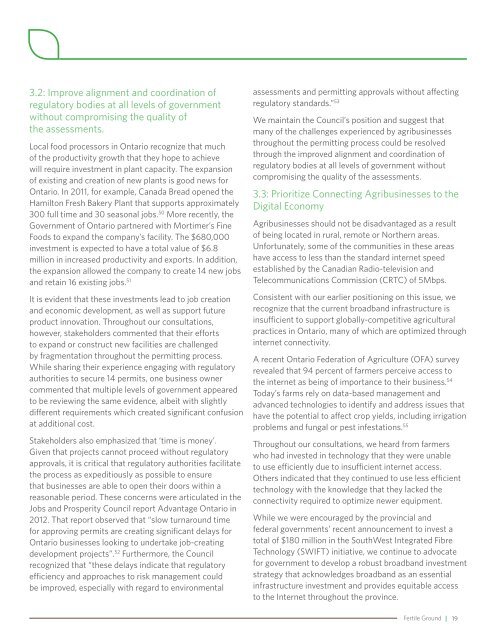FERTILE GROUND
2dJbGU4
2dJbGU4
Create successful ePaper yourself
Turn your PDF publications into a flip-book with our unique Google optimized e-Paper software.
3.2: Improve alignment and coordination of<br />
regulatory bodies at all levels of government<br />
without compromising the quality of<br />
the assessments.<br />
Local food processors in Ontario recognize that much<br />
of the productivity growth that they hope to achieve<br />
will require investment in plant capacity. The expansion<br />
of existing and creation of new plants is good news for<br />
Ontario. In 2011, for example, Canada Bread opened the<br />
Hamilton Fresh Bakery Plant that supports approximately<br />
300 full time and 30 seasonal jobs. 50 More recently, the<br />
Government of Ontario partnered with Mortimer’s Fine<br />
Foods to expand the company’s facility. The $680,000<br />
investment is expected to have a total value of $6.8<br />
million in increased productivity and exports. In addition,<br />
the expansion allowed the company to create 14 new jobs<br />
and retain 16 existing jobs. 51<br />
It is evident that these investments lead to job creation<br />
and economic development, as well as support future<br />
product innovation. Throughout our consultations,<br />
however, stakeholders commented that their efforts<br />
to expand or construct new facilities are challenged<br />
by fragmentation throughout the permitting process.<br />
While sharing their experience engaging with regulatory<br />
authorities to secure 14 permits, one business owner<br />
commented that multiple levels of government appeared<br />
to be reviewing the same evidence, albeit with slightly<br />
different requirements which created significant confusion<br />
at additional cost.<br />
Stakeholders also emphasized that ‘time is money’.<br />
Given that projects cannot proceed without regulatory<br />
approvals, it is critical that regulatory authorities facilitate<br />
the process as expeditiously as possible to ensure<br />
that businesses are able to open their doors within a<br />
reasonable period. These concerns were articulated in the<br />
Jobs and Prosperity Council report Advantage Ontario in<br />
2012. That report observed that “slow turnaround time<br />
for approving permits are creating significant delays for<br />
Ontario businesses looking to undertake job-creating<br />
development projects”. 52 Furthermore, the Council<br />
recognized that “these delays indicate that regulatory<br />
efficiency and approaches to risk management could<br />
be improved, especially with regard to environmental<br />
assessments and permitting approvals without affecting<br />
regulatory standards.” 53<br />
We maintain the Council’s position and suggest that<br />
many of the challenges experienced by agribusinesses<br />
throughout the permitting process could be resolved<br />
through the improved alignment and coordination of<br />
regulatory bodies at all levels of government without<br />
compromising the quality of the assessments.<br />
3.3: Prioritize Connecting Agribusinesses to the<br />
Digital Economy<br />
Agribusinesses should not be disadvantaged as a result<br />
of being located in rural, remote or Northern areas.<br />
Unfortunately, some of the communities in these areas<br />
have access to less than the standard internet speed<br />
established by the Canadian Radio-television and<br />
Telecommunications Commission (CRTC) of 5Mbps.<br />
Consistent with our earlier positioning on this issue, we<br />
recognize that the current broadband infrastructure is<br />
insufficient to support globally-competitive agricultural<br />
practices in Ontario, many of which are optimized through<br />
internet connectivity.<br />
A recent Ontario Federation of Agriculture (OFA) survey<br />
revealed that 94 percent of farmers perceive access to<br />
the internet as being of importance to their business. 54<br />
Today’s farms rely on data-based management and<br />
advanced technologies to identify and address issues that<br />
have the potential to affect crop yields, including irrigation<br />
problems and fungal or pest infestations. 55<br />
Throughout our consultations, we heard from farmers<br />
who had invested in technology that they were unable<br />
to use efficiently due to insufficient internet access.<br />
Others indicated that they continued to use less efficient<br />
technology with the knowledge that they lacked the<br />
connectivity required to optimize newer equipment.<br />
While we were encouraged by the provincial and<br />
federal governments’ recent announcement to invest a<br />
total of $180 million in the SouthWest Integrated Fibre<br />
Technology (SWIFT) initiative, we continue to advocate<br />
for government to develop a robust broadband investment<br />
strategy that acknowledges broadband as an essential<br />
infrastructure investment and provides equitable access<br />
to the Internet throughout the province.<br />
Fertile Ground | 19


